Strategic workforce planning: How to leverage this talent acquisition strategy to prepare for the future
It’s hard to hire the right talent when you don’t know what your company needs.
Let’s say two IT positions vacate and you spend some time filling the roles…only to discover three months later that your organization would have benefitted from hiring one in-house IT professional and outsourcing the rest of the work.
This small discrepancy leads to unnecessary costs and the tough decision of which employee to keep.
Strategic workforce planning prevents this by telling you your future needs now.
This talent acquisition strategy helps you determine objectives, forecast needs, and plan your workforce with company goals in mind. This enables you to build a solid plan and find the best candidates.
This blog explains the importance and benefits of strategic workforce planning as well as nine best practices for implementation.
If you want to get straight to our nine tips, feel free to skip ahead.
Table of contents
- What is strategic workforce planning?
- Why is a strategic workforce plan important?
- The benefits of strategic workforce planning
- 9 best practices for leveraging a strategic workforce plan to acquire top talent
- 3 examples of companies succeeding with strategic workforce planning as a talent acquisition strategy
- Optimize your strategic workforce planning with talent assessments
What is strategic workforce planning?
Strategic workforce planning is the act of determining talent needs that align with the organization’s future goals, and then building a plan to make sure the company has the right skills and technologies to achieve those goals.
In the simplest terms, strategic workforce planning ensures you’re not over- or understaffed for any part of your operations.
This plan can help you tackle certain talent acquisition trends, such as hiring contingent workers to fill gaps in your workforce.
With strategic workforce planning, you match the strengths of your employees with the available roles to make sure everyone has the right conditions to excel in their position.
On top of the matching process, the definition of strategic workforce planning extends to your capacity. It helps you understand how many people you actually need for the operations of your business at present and in the future – avoiding:
Overstaffing: hiring too many people who then don’t have anything to do
Understaffing: not having enough people to successfully accomplish your goals
How does a strategic workforce planning process work?
What is workforce planning in HR? What are the usual steps?
Strategic workforce planning is directly linked to your specific organization, meaning we can’t give you all the details but can only discuss the steps in general.
You want to determine your company’s resources, its place in the market, and its short- and long-term goals. From there, you need to analyze your organizational data and plan your future hiring plan.
Here’s a quick step-by-step:
Market assessment: Determine your company's resources and capabilities, and evaluate the competition
Organizational strategy: Assess company goals and strategic objectives with insights from managers and executives
Analyze the data: Use data and metrics to learn which workers you need to hire to facilitate these outcomes
Build a hiring and upskilling strategy: Create a detailed plan outlining which roles you’ll fill externally and which you’ll upskill current staff for
Monitor progress: Measure and dynamically monitor your progress, ready to make agile changes when necessary
For a full guide on the subject, read our article on building a strategic workforce planning framework.
Why is a strategic workforce plan important?
A strategic workforce plan tells you where the company is right now and where it’ll be in the future – giving you crucial information for upskilling, hiring, and people planning.
Here are the details:
Agility in responding to talent shortages: Even if you aren’t dealing with talent gaps now, you may be in the future. An engineer who is two years away from retiring will leave a void, and if you’re not prepared, your business operations and finances will take a hit.
Cost and talent optimization: A while back, businesses could only choose from a local talent pool. Today, many companies are recruiting internationally, which means you can optimize costs and build a workforce to meet modern challenges.
Talent management: Business leaders need to think about nurturing employees so they can take on more senior roles in the company. It’s more effective and affordable to train an internal worker than it is to hire someone externally.
Flexibility: Estimates show there are more than 70 million freelancers in the US alone.[1] When creating a strategic workforce plan, you should consider gig workers and how they can contribute during large projects.
Let’s briefly talk about that last point.
Hiring contingent workers is an excellent tactic to reduce costs, encourage a dynamic workforce, and trial new positions.
A survey by BranchApp found 85% of respondents have increased or plan to increase their gig work, with 45% citing inflation as the primary reason.
Strategic workforce planning benefits candidates and employees, too.
First, it discovers upskilling opportunities to help employees grow their careers. Professional growth is key to job satisfaction, and it also attracts new talent.
Second, effective workforce planning tells you the skill sets and roles your company needs, which helps you hire individuals who suit their positions better. This leads to employees who are happier and more confident in their roles.
This is also beneficial for employers: Closely aligning employees with job roles massively boosts hiring efficiency.
The benefits of strategic workforce planning
A strategic workforce plan isn’t a nice-to-have – it’s a must for many companies and organizations if they want to stay competitive.
Workforce planning helps you anticipate workforce gaps and zero in on your hiring needs.
This means it not only informs standard hiring initiatives but also benefits other talent acquisition efforts, such as campus recruitment.
The ability to anticipate workforce gaps
The first and biggest benefit of strategic workforce planning is anticipating workforce gaps. No matter the industry, every single organization felt the effect of the Great Resignation during the 2020-2022 period.
Businesses that had a strategic workforce plan managed to overcome this faster than those that didn’t.
Businesses need an action plan for retiring employees and for:
Market trends and movements in the employee market
The availability of talent for certain roles
The satisfaction level of current employees
The churn and employee turnover rate of their organization
It’s necessary to consider all of those factors if you want your organization to correctly anticipate skills gaps.
If you have a strategic workforce plan in place, you have an easier time seeing and reacting quickly to all of these disrupting effects.
For example, Unilever built a culture of talent sharing nearly a year before the pandemic. This practice enabled them to fill 9,000 roles quickly and easily during a dire time.
An accurate understanding of your current workforce’s capacity
Analyzing your current workforce helps you evaluate your strengths and the potential risks your organization might face. With an analysis, you understand what your current company’s capacity is.
Equipped with this information, you know which projects you’re able to handle successfully and which projects require you to hire more people.
How important is this? A study by Pew Research found 39% of adults who quit a job in 2020 said the reason was working too many hours. On the other hand, 30% of them cited working too few hours.
Strategic workforce planning helps you prepare for the future. Knowing what needs to be upgraded (and downgraded) in the company helps you become more competitive in the market.
Better results
Having a strategic workforce plan improves your company’s results.
You need to analyze your current workforce and understand what their strengths, weaknesses, skills, and capabilities are. This gives you objective insights on who to hire, enabling you to build an effective hiring plan.
Plus, if you use talent assessments to conduct a skills gap analysis and inform your workforce plan, you can use the same tests to hire new workers. This boosts consistency and quality. We touch on this later in this article.
A strategic workforce plan not only helps you hire better candidates; it also provides many insights into how to use your workforce better.
Helps you plan upskilling initiatives for your existing employees
Strategic workforce planning helps you understand your workforce on a deeper level. You might find employees who would be a better fit and would produce better results if upskilled for other roles in your company.
Let’s say one of your employees is an editor who’s also an excellent writer. This employee can now take on a small number of writing tasks each week.
Strategic workforce planning also helps you gain a deep understanding of what your workforce needs to perform better, which in turn enables you to design the right learning and development initiatives and execute a capability building strategy.
This article on Harvard Business Review states that more than 60% of a company's future roles can be filled by current employees with the right upskilling programs.
Boosts your succession planning efforts
A strategic workforce plan helps you know your future needs, which in turn helps you manage your talent pipeline and keep it filled with quality candidates.
A healthy talent pipeline helps succession planning efforts, enabling you to react quickly and efficiently when an employee retires or moves to a new role.
This is a great business strategy to combine with passive recruiting.
For example, a sales manager is projected to retire in one year. You spend this year conducting passive recruitment, including:
Researching professionals who suit the role
Breaking the ice and introducing yourself
By the time this sales manager is on the verge of retirement, your preferred passive candidate is ready to switch to “active” and join your company.
9 best practices for leveraging a strategic workforce plan to acquire top talent
Building a plan for the present and future strengthens a company for the long haul – these strategic workforce planning best practices help you do just that.
These tactics include determining your business goals, leveraging talent acquisition technology, and monitoring your plan over time.
Let’s dive in.
Strategies for strategic workforce planning: A summary
Strategies | Description |
1. Determine short- and long-term goals | Consider your current impact, but also take care to plan for your company’s long-term future |
2. Conduct a skills gap analysis | Assess your workforce’s strengths and weaknesses to inform your plan |
3. Coordinate your workforce plan with development initiatives | Learning and development go hand in hand with workforce planning |
4. Use talent assessments to fill gaps efficiently and effectively | Ditch subjective resumes and instead efficiently hire for your business needs with objective skills tests |
5. Align your workforce plan to your company’s strategies and values | Don’t only hire for headcount – consider your company’s specific goals and values |
6. Regularly update and reassess your strategic workforce plan | Monitor and update your strategy to match your shifting, dynamic organization |
7. Align your company to get valuable insights | Encourage departments to work together to build an accurate workforce plan |
8. Use the right metrics | Monitor and measure crucial people metrics, such as internal mobility rate |
9. Stay flexible | Be ready to change your plan because your needs change and so does the world |
1. Determine short- and long-term goals
A company lives short-term but thrives long-term.
So when creating a strategic workforce plan, you need to take into account both your short-term and long-term goals.
In the short term, you need to ensure your company can operate without disruptions and complete all projects successfully and profitably.
At the same time, you can’t neglect long-term goals. You need to plan ahead and implement a long-term plan to guarantee your company can thrive for years to come.
Imagine a company needs to prioritize a fair hiring CSR strategy in the long term, but in the short term, it needs to reduce costs.
This company consolidates these strategic goals by slowly adopting new hiring practices. It starts with a few talent assessments alongside its traditional hiring methods and expands throughout the year.
2. Conduct a skills gap analysis
A skills gap analysis is a crucial part of a strategic workforce plan. It helps you discover your workforce’s skills and areas of improvement, which in turn uncovers your hiring needs.
This determines your short-term goals and also helps you uncover your long-term goals.
For example, you might find projects that need Python coding skills have been increasing over the past six months. Your analysis then reveals you have two team members with this skill.
You then estimate the growing need for more programmers in the future, showing that you’ll soon have a skills gap in programming talent – a gap you need to address now to avoid future problems.
3. Coordinate your workforce plan with development initiatives
It’s a great idea to coordinate your workforce plan with employee development and career pathing initiatives.
As we mentioned earlier, more than half of your future roles can be filled with internal hires, so training and development are essential.
Take the time to align your workforce plan with your training programs. Ensure they’re working together; inform your development plan with your workforce plan and vice versa.
For example, a content marketing agency is scaling and needs to plan for future workers. It anticipates needing 10 new writers and two new content strategists.
The team determines the best route is upskilling one of the current writers into a content strategist position, and then externally hiring the other content strategist and writers.
You can make this process easier by using talent assessments. Use skills tests to assess workers to see if they’re ready for growth, monitor their development, and then verify their new skills.
You combine testing with the 9-box grid, a 3×3 model with 2 axes – performance and potential – to spot and categorize the workers with greatest potential for growth.
For more information, read our guide on learning and development.
4. Use talent assessments to fill gaps efficiently and effectively
Once you know which roles need filling, talent assessment tests help you plug workforce gaps quickly and efficiently.
These tests objectively measure skills, personality, and behavioral competencies so you can accurately fulfill your recruitment needs.
Further, using talent assessments is an inclusive hiring strategy, which enables you to pull candidates from a wider talent pool and more easily fill critical roles.
Data driven recruiting leads to better results and better hires. Let’s see how it works with TestGorilla.
First, you send assessments to applicants. Once they’re finished, you receive data-driven results instead of having to screen subjective resumes.
Here’s a sample results page. You can see the candidate had an average performance in design thinking and UI design, but a great score in prototype and testing.
This strategy is especially effective if you conduct a skills gap analysis with talent assessments and then use the same tests to fill those gaps, increasing consistency.
And using pre-employment testing significantly speeds up the hiring process. Revolut, a financial technology company, improved their time-to-hire by 30% to 40% when they started using talent assessments.
5. Align your workforce plan to your company's strategies and values
It’s important to align your strategic workforce plan and people strategy to your company’s goals, values, and corporate identity.
Here’s how you might coordinate your plan with your values:
Company A values diversity and wants to build employer branding around DE&I. Its talent acquisition manager works diversity initiatives and fair hiring into the workforce plan. This helps the company increase its number of diverse candidates.
Let’s look at one more example, this time for an organization aligning its goals to its workforce plan.
Company B has a goal to increase sales of a struggling product. Its talent acquisition manager sets a goal of hiring new sales representatives into the workforce plan to specifically boost this product.
6. Regularly update and reassess your strategic workforce plan
Commit to continuous improvement and regularly update and reassess your plan.
No company stays the same forever, and it pays to regularly evaluate your strategy, refresh any stale part of the plan, and update your talent pool.
For example, your workforce plan might show that you need an increase in retail workers, so you update your talent pool and begin scoping out the best professionals.
This growth might be a one-time event. After a reassessment, you might find that the need has slowed down and you must change your strategy to avoid hiring too many retail workers.
This tactic works well combined with active talent pool management.
7. Align your company to get valuable insights
You aren’t going at this alone – at least, you shouldn’t be.
It’s important to align departments and get insights from different people. Coordinate different teams – such as hiring managers, human resources, and finances – for the deepest insights and best results.
One study found 49% of leaders believe an inability to connect operational, people, and financial data to business outcomes impairs agility. And only 12% say their organization’s data is fully accessible to those who need it.[2]
Here are a few ways to encourage collaboration:
Ask for advice and insights
Share reports and ask for input
Ask for feedback on strategies
Working together, finance and HR teams can accommodate large changes, link workforce plans to strategy, and meet the demand for restructures and acquisitions.
This also helps build a good company culture based on collaboration and coordination.
8. Use the right metrics
A strategic workforce plan is best supported by the right metrics. The only way to know whether it was successful or not is to define objectives and measure the outcomes.
For example, when developing new learning and development initiatives, you need to know which skills to teach and how you’ll evaluate results.
Here are a few common metrics to measure:
Headcount
Internal mobility rate
Diversity ratio
Retention
Turnover
Hiring managers need to know how many people they need to hire for a specific role, what skills they need to look for, and how success will be measured.
Using the right metrics can make all the difference between having a successful strategic workforce plan and one that simply falls through.
9. Stay flexible
Planning is essential, but rigid plans won’t help.
Maybe you had a great strategic workforce plan a few years ago, and then the pandemic hit. And shortly after, the Great Resignation. No amount of planning could have prepared you for those two events.
So even though planning is essential, plans need to stay flexible. There will be external events and situations that you simply can’t prepare for, so you need to be able to adjust your plans accordingly.
Agile strategic workforce planning helps you stay flexible, with your mind on your goals but the ability to bend when you need to.
For more information on building a dynamic company, read our article on how skills-based organizations become adaptable.
3 examples of companies succeeding with strategic workforce planning as a talent acquisition strategy
Let’s take a quick look at some strategic workforce planning examples from real-life companies.
Companies with successful workforce planning efforts: A summary
Company | Why it’s successful |
Telkom | Used talent assessments to conduct a skills gap analysis, then used the data to hire internally and externally |
Subway | Leveraged skills tests to learn the key skills for success, reducing training costs and facilitating recruitment |
Siemens | Built a workforce plan defining emerging skills, new roles, and competitor strategies |
Telkom
Telkom, an information and communications enterprise, had big plans to digitally transform its entire business. This included three new business portfolios and brand-new technologies.
It needed to digitally transform its workforce with new technical skills.
This company used talent assessments to conduct a skills gap analysis of more than 10,000 employees, comparing its digital initiatives against global benchmarks.
The results of this analysis gave Telkom the crucial insights it needed to upgrade its workforce. It then developed a strategy to hire some new external workers but to use internal recruitment wherever possible.
Because this company used talent assessments for its skills gap, it also had detailed, objective information to build personalized development plans for each worker.[3]
Subway
One Subway franchise owned by Harold Jackson consistently struggled with employee retention, which in turn led to disengagement and poor customer service.
Harold knew he had to focus on his talent strategy, so he worked on his workforce plan.
He started using talent assessments to understand his workforce – first to predict the best people for each role, but it extended beyond that.
His plan helped him accurately hire new workers and determine key criteria for high performers and future leaders. This enabled him to build leadership development plans for his top employees.
This strategy not only increased retention and improved employee engagement, but it also reduced training costs by aligning candidates with suitable roles.[4]
Siemens
Siemens, a multinational technology company, optimizes its talent acquisition with strategic workforce planning.
This company always knew the benefits of using data and analytics to inform business practices, and this was simply another opportunity to improve outcomes.
Siemens used strategic workforce planning to learn about its competitors and discover trending skills and emerging roles. Further, it was able to learn competitor benchmarks for these emerging roles and skills.
This essential information helped it build effective employee development paths, adopt new hiring practices, and learn which skills to focus on in both endeavors.[5]
Optimize your strategic workforce planning with talent assessments
Adopting a strategic workforce planning process enables you to prepare for the near and distant future.
It’s a crucial talent acquisition strategy that shows you the strengths and weaknesses of your workforce and gives you insights to assist your hiring and development efforts.
This process is much quicker and easier when you leverage strategic workforce planning software like talent assessments. These tools give you objective data to inform your process with little guesswork.
For more on this topic, read our blog on talent acquisition analytics.
If you’d like to learn more about talent assessments, check out our test library of more than 300 tests.
Sources
"Freelancing in America: 2017". (September 28, 2017). SlideShare. Retrieved September 14, 2023. https://www.slideshare.net/upwork/freelancing-in-america-2017
“Stepping Up Workforce Planning Strategy by Closing the HR-Finance Gap”. (January 24, 2023). Harvard Business Review. Retrieved September 14, 2023. https://hbr.org/sponsored/2023/01/stepping-up-workforce-planning-strategy-by-closing-the-hr-finance-gap
"Building a future-ready workforce: How Telkom led its employees on the path of digital transformation". Mercer Mettl. Retrieved September 14, 2023. https://mettl.com/clients/telkom/
“A fresh take: How Subway improved employee and customer experience with PI”. Predictive Index. Retrieved September 14, 2023. https://www.predictiveindex.com/customer-stories/subway-case-study/
“Siemens: Benchmarked Against Labor Market Competitors & Future Trends”. HR Forecast. Retrieved September 14, 2023. https://hrforecast.com/portfolio-item/siemens-benchmarked-against-labor-market-competitors-future-trends/
Related posts
Hire the best candidates with TestGorilla
Create pre-employment assessments in minutes to screen candidates, save time, and hire the best talent.
Latest posts
The best advice in pre-employment testing, in your inbox.
No spam. Unsubscribe at any time.

Hire the best. No bias. No stress.
Our screening tests identify the best candidates and make your hiring decisions faster, easier, and bias-free.
Free resources
This checklist covers key features you should look for when choosing a skills testing platform
This resource will help you develop an onboarding checklist for new hires.
How to assess your candidates' attention to detail.
Learn how to get human resources certified through HRCI or SHRM.
Learn how you can improve the level of talent at your company.
Learn how CapitalT reduced hiring bias with online skills assessments.
Learn how to make the resume process more efficient and more effective.
Improve your hiring strategy with these 7 critical recruitment metrics.
Learn how Sukhi decreased time spent reviewing resumes by 83%!
Hire more efficiently with these hacks that 99% of recruiters aren't using.
Make a business case for diversity and inclusion initiatives with this data.























